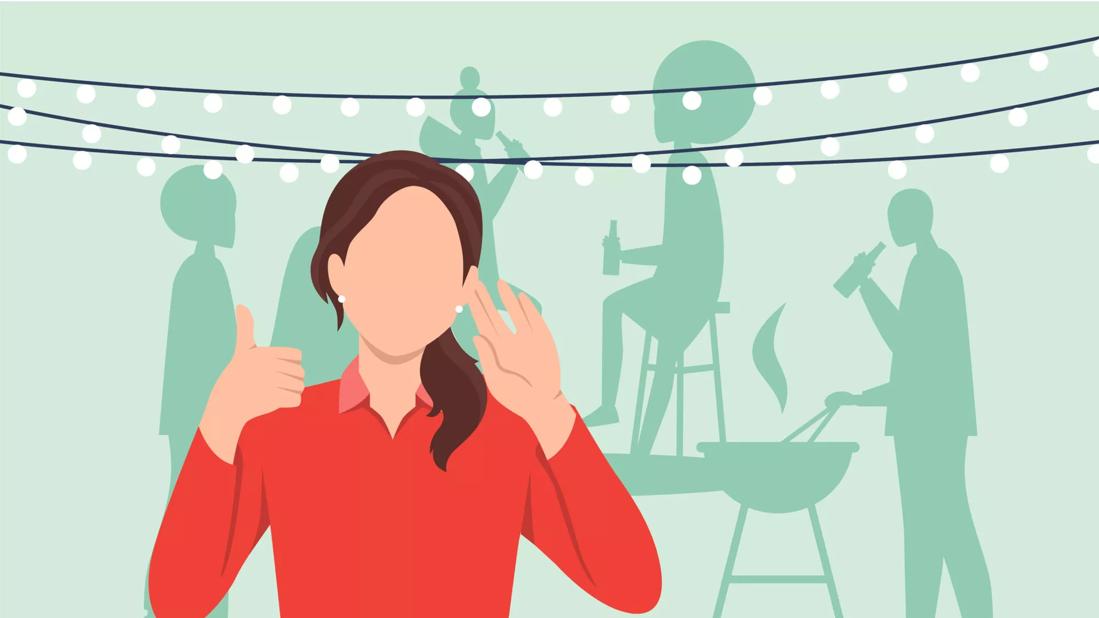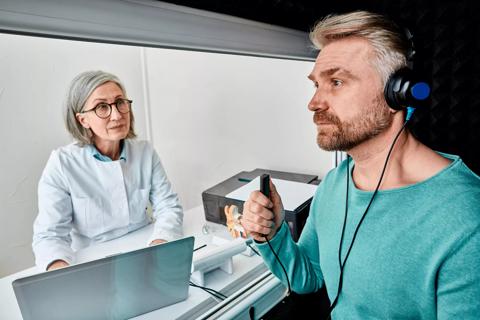There are lots of tips, tricks and assistive devices out there that can help

If you’re looking to catch up with a friend, attending a noisy party isn’t always the best setting. For people who live with hearing loss, socializing in loud spaces can even be more challenging.
Advertisement
Cleveland Clinic is a non-profit academic medical center. Advertising on our site helps support our mission. We do not endorse non-Cleveland Clinic products or services. Policy
Hearing loss is more common than you might think. According to an article in The Lancet, as of 2019 approximately 1.57 billion people around the world had hearing loss.
While it’s a common problem, navigating social settings with hearing loss can be difficult. Audiologist Sarah Sydlowski, AuD, PhD, MBA, offers some tips.
Why are social situations particularly difficult for people with hearing loss? Dr. Sydlowski says it boils down to the fact that social settings are “unpredictable,” for a few reasons.
“They’re environments that are hard to control,” she says. “They’re not usually a quiet room where you have someone who’s seated directly across from you so you can easily watch their face for visual cues and pick up most of their words.”
In many social settings, you also have multiple conversations involving multiple people going on at once — plus noise in the background. “Other things are competing with the information that you want to hear,” Dr. Sydlowski explains. “The hard surfaces in the environment might create a lot of reverberation. There’s a lot going on that competes for your focus.”
This can also add stress because you often need to use more cognitive effort to pay attention to what’s going on, she notes. “You might be a little bit more attuned to the idea that you could be mishearing something. You don’t want to respond incorrectly or look like you’re not following the conversation.”
Advertisement
This can be fatiguing, Dr. Sydlowski continues. “You have to work so much harder than anyone else to stay engaged and to stay connected.”
Understandably, this stress, fatigue and frustration might lead to you deciding to stay home.
“I frequently see people living with hearing loss who have decided not to go to the social events that they like to go to,” says Dr. Sydlowski. “Or when family comes over for a big get together, they sit on a couch over in the corner and watch the activities rather than directly engaging with them.”
This can also affect another important aspect of life: Your career. “I know people who have decided that they have to retire early, or they can’t stay in the workforce in the way that they want to. This is particularly true when the hearing loss is unmanaged or under-managed,” she continues.
Having hearing loss that’s undermanaged is “probably one of the least understood or recognized” situations, Dr. Sydlowski adds.
“People usually think getting a device is it,” she says. “But you might not have been recommended the most appropriate device, or it may not be programmed effectively. Perhaps you haven’t been encouraged to undergo auditory training or rehabilitation. Or you may not have been exposed to all of the accessories or communication techniques you could be using.”
It’s understandable that you might not always feel comfortable advocating for yourself in certain social settings. “Some of it depends on how well you know the people in the environment where you are,” notes Dr. Sydlowski. “There are some circumstances where you might want to be a little bit more discreet. But advocating for yourself is essential.”
The following strategies for your communication partners will make social settings easier to navigate.
In general, it’s best in any setting to tell who you’re talking with to speak slowly and clearly — not loudly.
“Louder isn’t necessarily clearer,” clarifies Dr. Sydlowski. “It’s a lot like if you turn your stereo up louder. It doesn’t mean that your music actually gets clearer. In fact, it can in some cases actually get more distorted. Clearer, well enunciated speech is always going to be more effective.”
Hearing aids and cochlear implants can’t make noise disappear — or sort voices in order of importance. “It’s hard for the microphone to know the voice that you care about the most, or which conversation you’re trying to focus on,” explains Dr. Sydlowski. “Everybody always wishes that you could just eliminate everything you don’t want to hear, but technology’s not that smart yet. The device can only be as good as what makes it to the microphone.”
Advertisement
Remote microphones and FM systems can really be beneficial in social settings to help overcome this challenge. FM systems and remote microphones systems consist of a microphone that your communication partner or someone else — for example, someone giving a speech at the front of a room at a podium — can wear or have near them that transmits sound directly to the listener’s ear.
“The transmitter wirelessly transmits sound directly to the hearing device you’re wearing — usually a hearing aid or cochlear implant,” Dr. Sydlowski further explains. “Remote microphones that someone else can wear are usually the best because the closer you get the microphone to the voice you want to hear, the better the signal will be.”
The advantage of a device like this? It’s perfect for situations where there’s background noise, the speaker is at a distance or there’s a lot of reverberation — the microphone can be placed very close to the person’s mouth. “The result is it sounds like their voice is only inches away from your ear rather than many feet,” she says.
Small gatherings give you the most flexibility in finding the best place for you to communicate and have a conversation.
Larger parties can be more challenging. Dr. Sydlowski says if you and your group can sit in a quieter corner or space that’s not next to a band, the kitchen or other extraneous noise, that’s ideal.
Advertisement
She also says these parties are a good environment for remote microphones, especially if you’re trying to have a conversation with an individual or potentially a small group of three or four people. “If you’re willing to pass that microphone around, or even point it in the direction of the person you want to hear, that can be very helpful.”
In meetings, sitting closer to the front is usually most beneficial. Remote microphones can typically transmit over 20 feet, but sitting closer where you can also see visual cues is an additional aid.
At restaurants, choose a table that’s against a wall, and take the seat facing the wall. “Most people do the exact opposite,” Dr. Sydlowski shares. “They think that the seat with their back against the wall is the best seat.”
That’s not necessarily ideal because of the way hearing devices work best, she says. “Microphones pick up more what’s in front of you, because they assume that you want to hear the person in front of you. When you face the wall, all the noise of the restaurant is to your back. And the people you want to see are in front of you.”
Choosing a well-lit restaurant is also preferable. “To help you hear better, it’s really important to be able to see the face of the person that you’re talking to,” reiterates Dr. Sydlowski. “Seeing those visual cues can be really valuable.”
Advertisement
In the past, the stigma of wearing a visible (or even invisible) hearing device tended to be something you might have to deal with. Luckily, times are changing.
“We’re moving into an era now where everybody has something hanging out of their ears all the time,” Dr. Sydlowski says. “There’s a different feeling about wanting to be able to access technology, whatever that technology is, whatever that looks like. I’m really hopeful that that’s going to carry over to hearing also.”
In addition to remote mics and FM systems, Dr. Sydlowski breaks down four different kinds of technical solutions that can make it easier to manage hearing loss in social situations. They are:
These options — used alone or together — can help you focus less on hearing, and more on the fun you’re having.
Hearing devices — what are commonly known as hearing aids or cochlear implants — are “intended to give the listening more access to sound they would otherwise be missing,” says Dr. Sydlowski.
Hearing aids pick up sound in your environment and make these sounds louder and clearer. They rely on the sensory cells in your inner ear still being able to send the signal clearly to the hearing nerve. Cochlear implants for the most part bypass the hearing system in your inner ear, and directly stimulate the hearing nerve. They’re most appropriate when hearing aids are making sound louder, but can’t make it as clear as it needs to be.
“Hearing aids sometimes can’t provide as much benefit as someone needs by making sounds louder,” Dr. Sydlowski explains. “That’s because you don’t have enough residual hearing function to respond appropriately. A cochlear implant can be a better option because it can provide not only sound audibility, but also clarity.”
Additionally, assistive devices work with hearing aids and cochlear implants to take advantage of built-in streaming technology capabilities. “For example, most manufacturers of implants and hearing aids have some accessories that you can attach to your television,” says Dr. Sydlowski. “Rather than the sound coming out of your speaker where it has to travel across the room, might bounce off some hard surfaces or decrease in volume, it wirelessly streams it directly into the hearing device.” Remote microphones also fall in this category.
Many cell phones can now stream directly to hearing devices. Additionally, some smartphones have a feature that turns your phone into a remote microphone. “If your hearing device is paired to your phone, you can hand somebody the phone or set it up on the table,” Dr. Sydlowski explains. “It picks up the voice just like a remote microphone and sends it to your hearing aid.”
Some hearing devices can connect to either a landline or a cell phone via Bluetooth® technology. “The device itself acts sort of like a wireless earbud would,” Dr. Sydlowski says. “It picks up the signal from the phone and sends it directly into your hearing device.”
While out and about in public at places like a theater or taxi or in public buildings like a post office, you might see signs for a telecoil system. This looks like an ear with a line through it, either with or without a letter T.
“This indicates either what’s called a room loop, or a personal neck loop, that you can use if you have the telecoil in your hearing device enabled,” says Dr. Sydlowski. “That’s literally just a little coil inside that hearing device. And when you turn it on, it connects with the signal from the room loop or the personal loop that you’re wearing.”
With a room loop, there’s usually a wire embedded in the floor or in the walls. As long as you turn your telecoil on and you’re within the range of that loop, you’ll receive whatever signal is being broadcast.
“That’s usually the voice of a person speaking into a microphone up at a podium, or in the case of a pharmacy counter or post office, the person behind the glass who might be talking to you,” she notes.
In places like the theater, you can rent or borrow a personal neck loop for the event, she adds. “That goes around your neck, and it picks up the signal the same way.”
You’ve probably seen (or used) closed captioning option for movies or TV shows. That’s just the tip of the iceberg. For example, there are also speech-to-text programs that work with cell phones.
“There are many different programs that you can use with a mobile phone or cell phone that will convert the voice that you’re hearing into captioning,” Dr. Sydlowski says. “There are also apps on your phone itself you can turn on. And if you’re in an environment where you’re not hearing someone clearly, it will convert their voice into text in real time.”
Dr. Sydlowski recognizes that navigating hearing loss can sometimes be challenging. “Frequently, people think that there’s nothing that they can do about hearing loss, or they feel kind of powerless about their chances of doing better in a social situation or staying connected and engaged.”
For example, only about 20% to 30% of people who need hearing aids use them — and the percentage is even lower for cochlear implants. “A lot of that has to do with people not knowing or recognizing these implants are an option,” she explains. “They say, ‘I thought hearing aids were my only option. I was told there was nothing more that could be done for me.’”
But there are options wherever you go to make navigating hearing loss easier.
And Dr. Sydlowski stresses that there are multiple good options out there, not just for hearing devices, but also to navigate the hearing loss in many different ways. In short, there is hope.
“Before you give up on or withdraw from the social situations you love, talk to an audiologist,” she advises. “They can really get into all of those options with you and make sure that you’ve heard about all of your choices.”
Learn more about our editorial process.
Advertisement

Sudden hearing loss can have many causes — but it’s important to seek treatment fast

Hearing aids can be enough for some people, but other devices — like for your phone, TV and fire alarm — can help, too

Untreated hearing loss can affect kids’ speech and language development and their overall quality of life

Reduce background noise, don’t talk too fast or too slow and above all, ask what’s most helpful to them

COVID-19 may be associated with tinnitus, but research is still ongoing

Ringing is already a sign of damage, but you can take steps to keep your hearing protected

Keeping your brain healthy is key

Understand the symptoms and find relief

The best parenting style balances enforcing rules and showing plenty of love

Tips include cutting back on sugar, focusing on exercise and managing stress

It can be harder to let go when you’ve invested time, energy and emotions — but it might be the healthier choice long term